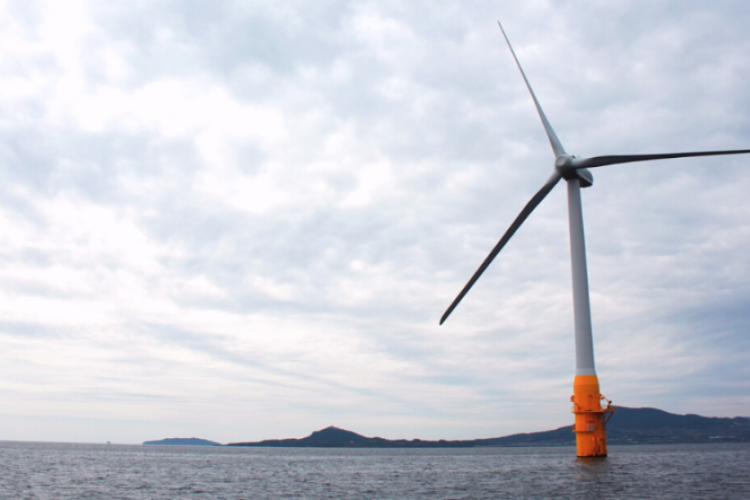A 3D printed anchor and a self-charging mooring line monitoring device are two of eight technologies announced today as winners of a technology acceleration competition, funded by the Scottish government and run by the Carbon Trust’s Floating Wind Joint Industry Project (JIP).
The competition was designed to address four key industry challenge area that need to be overcome to commercialise floating wind. The four areas were identified in Phase 1 of the Floating Wind JIP: monitoring and inspection, mooring systems, heavy lift maintenance and ‘tow to port’ maintenance.
The eight technologies will receive a share of £1m from the Scottish government, in addition to support from the 14 leading offshore wind developers represented in the Floating Wind JIP.
The successful applicants are from a variety of sectors including oil & gas, IT & telecommunications and engineering. The innovations range in maturity, therefore the funding will be used to support different activities from desktop studies to offshore demonstration.
The companies and their winning technologies are:

- Fugro, AS Mosley and University of Strathclyde (monitoring and inspection) - Condition monitoring software which uses readily available acceleration and motion data points from floating offshore wind structures to extrapolate how the wider structure responds to stress.
- Technology from Ideas and WFS Technologies (monitoring and inspection) - A load monitoring system to identify stresses on mooring lines and times when maintenance is needed. The monitoring system will be integrated into an existing spring, which also acts as a dampener on mooring lines, and is powered by movement of the lines.
- Dublin Offshore (mooring systems) - A load reduction device that sits partway up the mooring line and pivots in the water to minimise movement of the floating platform during wave events.
- Intelligent Mooring Systems and University of Exeter (mooring systems) - A new pressure-based dampener which sits between the platform and mooring line to reduce the load on floating platforms.
- RCAM Technologies and the Floating Wind Technology Company (mooring systems) - A concrete anchor, produced using 3D printing technology, which is sunk and then embedded in the seabed through suction.
- Vryhof (mooring systems) - An adjustable lock on the seabed used to manipulate the tension of the mooring lines. This is an alternative to a winch sitting on the turbine platform, and enables vessels to adjust the tension of mooring lines at a safe distance from the platform.
- Conbit (heavy lift maintenance) - A temporary crane which sits on top of the turbine (the nacelle) to winch parts up and down for maintenance. This could enable larger turbines to be serviced offshore than is currently feasible.
- Aker Solutions (‘tow to port’ maintenance) - A splice box connecting two dynamic array cables, and allowing them to be wet-stored on the seabed when a turbine is towed to port. This will also enable an array of floating wind turbines to remain operational when one floating platform is removed for maintenance.
Fugro project manager Dr Stuart Killbourn said: “We are delighted to have won this technology development grant from the Carbon Trust and the Scottish Government. We are looking forward to developing a transformative condition monitoring software package for floating structure mooring lines, which will significantly reduce the need for personnel and vessel activities offshore. This is a key enabler towards the deployment of floating wind turbines in Scottish waters and the generation of clean renewable energy to meet the nation’s needs.”
The Carbon Trust said that floating offshore wind is an emerging renewables sector, with significance for places like Scotland where water depths often do not allow for the use of fixed bottom turbines. It said that floating wind is forecast to scale up to 12GW of capacity globally by 2030, becoming a market estimated to be worth £32bn.
Paul Wheelhouse, minister for energy, Scotland, commented: “We are funding the Carbon Trust’s Floating Wind Technology Acceleration Competition in order to address key technical challenges in the sector. Given Scotland’s unique deep water profile, floating offshore wind will undoubtedly play a huge role in our future energy system, as we transition to a net zero economy and we know that key overseas markets are also looking to exploit floating wind technology to meet their own energy needs. The innovative solutions developed by the competition winners will help reduce costs in the sector and could allow floating wind technology to reach commercial scale deployment earlier than previously anticipated and that could prove vital as Scotland and other coastal nations seek to head off the climate emergency.”
Carbon Trust director, offshore wind, Jan Matthiesen said: “Floating wind is on the precipice of scaling to deliver significant capacity in the energy system. The competition is supporting a number of exciting technology innovations in critical challenge areas identified by industry. We are excited and optimistic for both the potential of these innovations to reach commercialisation and their ability to positively impact the sector.”
Got a story? Email news@theconstructionindex.co.uk



